This post is comprised of different sections
Take a look at our review of Another Earth!
Learn more about the infinite universe!
This post is comprised of different sections
Take a look at our review of Another Earth!
Learn more about the infinite universe!
Director: Mike Cahill
Producer: Hunter Gray, Mike Cahill, Brit Marling, Nicholas Shumaker
Writer: Mike Cahill, Brit Marling
Starring: Brit Marling, William Mapother
Year: 2011
Duration: 1h 32 m
Country: U.S.A.
Language: English

Our rating

Your rating
While I was zapping through my ludicrously tiny film library, I came across a film called “Another earth”, and I thought to myself, “Well, why not entertain myself with a good old Sci-Fi film to realise how precarious our existence really is”.
I have seen a LOT of Sci-Fi films in my time, and was expecting another corny over the top disaster film.
I was wrong.
Another Earth was, in fact, quite thought-provoking. Granted, if you are only thrilled with stories about green, oversize-eyed, tiny-waist ETs destroying earth, simply live to see Margot Robbie in Yoga tights or Ryan Gosling shirtless, or are looking for inspiration for a PhD in astrophysics, then this film is probably not for you.
If, on the other hand, you don’t mind watching an indie film with an engaging story that will make you think twice next time you look into the sky, then why not giving this film a go.
Brit Marling plays Rhoda, a bright teenager, who will soon enter MIT to begin her studies in astrophysics. After attending a party, an inebriated Rhoda drives home and is momentarily distracted with the sight of a recently discovered planet that has been approaching Earth.
She crashes into another car, killing a woman and a boy, and leaving a man in a coma. After serving a jail sentence of 4 years, Rhoda struggles adjusting to her new life and decides to work as a janitor in a school, in order to keep interactions with people to a minimum.
She eventually learns that United Space Ventures (a private company run by a billionaire) is offering a trip to Earth Two, and she decides to participate. She also hears about the man in the accident who had awakened from his coma. Out of guilt, she concots a story about a trial cleaning and offers to clean his house. The two start to get along well, and have a brief romantic relationship.
“Another earth” has the peculiarity of most indie films, which look as though somebody is walking around with a camera, following the characters every move. It certainly gives the film a more intimate, if not surreal, ambience, which I quite enjoyed.
The acting was very good indeed: I thought Brit Marling’s acting, in particular, was spot-on. The inner struggle that her character experiences and the guilt that gnaws away at her confidence really transpires in the movie.
Alas, even though I did like the film, I have to admit that I was disappointed that the scientific treatment of the origin of Earth Two was barely nonexistent.
For instance, there was no real attempt to explain why astronomers hadn’t spotted another earth, which has only a radius of about 6350 km, plunging towards earth.
Or, perhaps more importantly, what the consequences of having another planet a few thousand kilometers from us really were. As it turns out, having another planet orbiting earth would not arouse any curiosity of any kind, because we would all most probably be, well…, dead.
First things first: you should know that geophysics isn’t really my forte, so apologies if my explanation sounds way oversimplified.
Let’s first try to understand how the Moon affects events on Earth, before we tackle the problem of having another equally-sized planet orbiting Earth.
I’m sure you have heard that the Moon is responsible for governing the tides on Earth (the Sun has also a noticeable influence but for the sake of simplicity let’s just focus on the Moon). How does that happen?
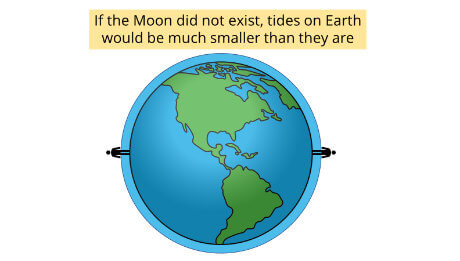

Well, the Moon is attracted to Earth, but Earth is also attracted to the Moon. Think of the Moon trying to pull Earth via invisible strings, and the strings are connected to both the continents and oceans.
In the place where the Earth is closest to the Moon you will see a big bulge forming. However, because water is way easier to displace than solid stuff like continents, the bulge will mainly consist of water. If you happen to be on a beach when the Moon is directly overhead, then you will experience a high tide.
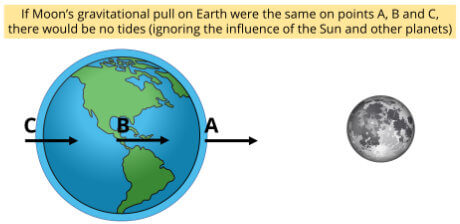
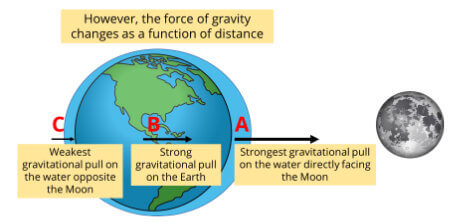
Now, someone standing on a beach on the opposite side of Earth will also see a high tide forming there, albeit smaller than the high tide directly facing the Moon.
It may sound counterintuitive, but think of it the following way.
Imagine 3 points on earth along a horizontal line (see the figure on the right above): point A is directly facing the moon, point B is at the center of the Earth, and point C is on the other side of Earth.
Point A will experience a lot of gravitational pull from the Moon. Point B will experience a little less gravitational pull from the Moon. Point C will experience the least gravitational pull from the moon. Why? If gravity was constant A, B and C would feel the exact same pull (see the figure on the left, above). But gravity isn’t constant over planetesimal distances – it gets weaker with distance. That’s why C will have the least pull from the Moon.
So, from the perspective of someone standing on the side opposite the moon, the water level will seem to increase because Earth’s crust on that side is being pulled slightly more strongly towards the moon than the surface of the water.
This is the reason why you have two tides per day – if you are in Greece when the moon is directly facing you, you will have a high tide. The Earth then rotates around it’s axes, and 12 hours after, Greece is on the other side and you will experience the second (slightly smaller) high tide.
Although I depicted it as such (for ease of visualisation), you should not think of the bulges as the result of the Moon pulling water towards it. It’s slightly inaccurate.
In fact, water from the oceans is sort of being “squeezed” towards the Earth-Moon line and piling up there.
This is pretty much like squeezing a pimple.
Imagine you were to change the size of the Earth to the size of a round doughnut with chocolate filling. If you gently squeezed the doughnut at the center, the filling would bulge outwards on both sides of it. The dough of the doughnut (the continents) also feel this pressure, but remain in pretty much the same place. The filling (oceans) is much more easily displaced.
Check out this video for a clear explanation of the phenomenon:

By the way, if you are concerned to go the toilet when the moon is right above you, don’t worry about water shooting out of the toilet due to the tidal force (although I should mention that in Japan they have toilets where you push a button and a jet of water sprays right off).
To be accurate, the Moon actually creates a tidal force on the water in your toilet, but because there are so few water molecules in comparison to the vastness of the ocean, the pull is really insignificant compared to the Earth’s gravity pulling them down, so they are kept where they are.
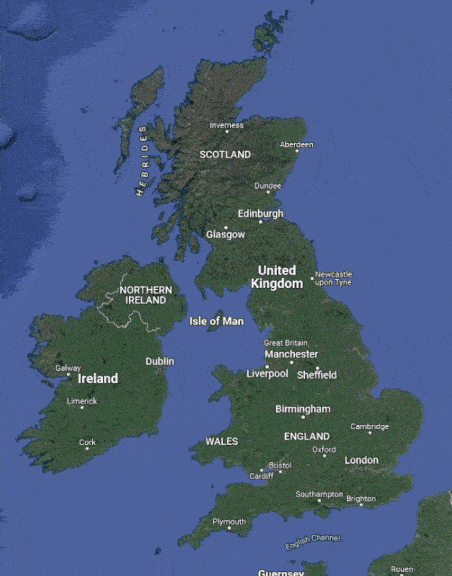

I think you can see where this is going. The Moon is about 4 times smaller than Earth, but is able to significantly govern tides on Earth.
So, if the Moon were to increase to the size of Earth, the tidal bulges would increase so dramatically that it would give rise to enormous tides. By enormous I mean ENORMOUS; big enough to submerge most coastal cities, and probably even entire countries such as the Bahamas and/or Cuba.
In other words, our Earth would be a terrifying place to be. So, the scene where Rhoda drives to the coast and stares at the ocean with Earth Two floating above her? Not happening!
Aside from the huge tides, which alone would be such a catastrophic event as to place humanity in great peril, they wouldn’t be the only effect that Earth Two could cause on our Earth. Here is a non-exhaustive list of catastrophes:
1. Earthquakes would be much more frequent due to stronger tidal effects on earth’s crust.
2. Earth’s rotation would slow down to the point that both Earths would always be seeing only one side (this is called tidal lock). When this happened, the water level would become stationary and there would be no tides (or a permanent “high tide” on the side facing Earth Two, and permanent “low tide” on the side opposite Earth Two).
3. One day would have more than 400 hours (our Earth hours). This means that the side facing the sun would have hundreds of hours of continuous sunlight, but it also means that the opposite side would experience hundreds of hours of darkness.
4. Day-night temperatures changes would be so drastic that most animal species would perish.
5. There would be significant disruptions to the magnetic field, so the risk of radiation poisoning would be a real danger.
6. Your weight would change considerably dependening on whether you were on the side facing Earth Two (you’d be heavier) or the opposite side of it (you’d be lighter). Not sure how humans would cope with that.
7. Of course, arable land would become extremly scarce, so famine would run rampant.
8. There would be a risk of atmosphere evaporating into space on the side opposite Earth Two, making it much harder for humans to breathe.
Second, the online draw for a visit to Earth Two was a bit illogical. I mean, I am fairly certain that world leaders would agree that the first expedition to an inhabited planet should be pioneered by only the most qualified of astronauts that have had extensive training in space, as well as the bloody guts to embark on a mission like this.
But no, you only really need to write a short precis of why you think you should be selected. What’s more, allowing to give your winning ticket to another person would most certainly be a recipe for disaster.
It’s understandable that the creative team did not wish to get bogged down in the scientific details, as this isn’t a science fiction or a natural disaster film, but, instead, the focus is on the drama of Rhoda’s life.
Still, the almost lack of scientific explanations was very off-putting to me. There have certainly been films that got this fairly right.
Take the comedy Bruce Almighty, starring Jim Carrey and Jennifer Anniston for example. There is a scene where Bruce pulls the moon closer to Earth as part of his plan to seduce Grace. The next day was met with cataclysmic hurricanes, earthquakes and whatnot.
Surely, there would have been ample opportunities to incorporate these aspects into the script of “Another Earth” without necessarily having to make it a major theme in the movie.
In general, I recommend the film. Sure, the evident scientific inaccuracy was a constant nagging feeling, but Rhoda’s struggle was moving and I think the acting was generally very good. Another Earth gets a rating of 3 stars.
The film moves at a slow pace, dialogues are mostly laconic and the intimacy with which the camera’s follow Rhoda’s life, give the film a slightly eerie mood.
However, Another Earth isn’t a weird film. Setting aside the ambiguity of the last scene (when Rhoda meets her doppelgänger), not much requires an explanation.
For this reason, Another Earth gets a Bizarrometer score of 1.
If you exclude the last scene, Another Earth is quite simple to understand. In fact, the reason that probably led you to this article is to understand why Rhoda from Earth Two (henceforth, Rhoda 2) visited Rhoda from Earth One (henceforth, Rhoda 1).
I’m sad to say that there isn’t enough information in the movie to answer this question with confidence.
But one thing is certain: the accident that sent Rhoda 1 to jail has likely only happened on Earth One.
According to a popular theory, the so-called Broken Mirror Theory, synchronicity of events between the two Earths was broken as soon as the two Earths got a glimpse of each other. That appeared to have happened a few days before the fatal accident that killed John’s wife and son. So, life on Earth One took a completely different course than life on Earth Two.
It’s also safe to assume the competition on Earth Two to visit Earth One did not take place.
First, the encounter between Rhoda 2 and Rhoda 1 happens four months after John from Earth One (henceforth, John 1) departed to Earth Two. Since the two Earths are technologically equivalent, why didn’t Earth One receive inhabitants from Earth Two at about the same time?
Second, since the accident on Earth One did not happen on Earth Two, Rhoda 2 and John from Earth Two (henceforth, John 2) never met. Without the emotional story that won Rhoda 1 the competition on Earth One, Rhoda 2 would likely never have been selected.
Still, Rhoda 2 did travel to Earth One, so why did she do it?
My guess is that Rhoda 2 finished her degree in MIT and became a successful astrophysicist – pay attention to how elegant Rhoda 2 is dressed, a potential sign that she is well-off.
I would venture to say that she is on Earth One on her own accord; possibly on a covert mission. I know, this is starting to sound like a plot for a conspiracy film, but, otherwise, why wouldn’t Rhoda 1 have heard in the news of a landing from Earth Two?
Maybe John 1, upon arriving on Earth Two, sought Rhoda 2 to tell her the story of Rhoda 1 back on Earth One.
During the film, Rhoda is seen to be a very sensitive and compassionate woman. Maybe Rhoda 2 felt it would be the right thing to do to give support to her doppelgänger.
Before expanding on this interpretation, I’ll describe some fascinating facts about the universe which will (hopefully) blow your mind, the way mine was blown.
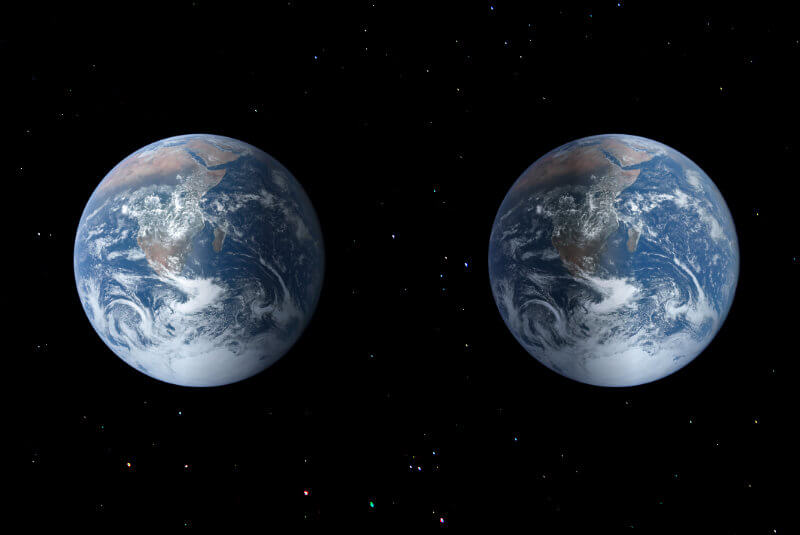
Ahhh, the universe, my favourite topic!
One question that has always bothered me though has been: what lies beyond the universe? Have you ever thought about it?
If not, here’s another question for you: imagine you were immortal and had a space rocket with a perpetual source of fuel. What if you set out your one-way ticket journey from Earth into unknown space? Would you ever hit a “wall”? If so, what would there be behind that wall? More space? What if you climbed the wall and continued your journey, would there eventually be a wall you could not cross? But if there is a wall you cannot cross, what is there behind that wall?
As a teenager, it was these sort of questions that filled many of my afternoons (I was a weird kid!).
Some astronomers are fervent believers that space extends infinitely. That is, if you fired your rocket you would never hit a wall, you would just go on forever and ever.
As we will see shortly, if you believe the theory of an infinite universe, there is nothing in the laws of physics that prevent multiple yous living on a planet they call Earth, reading this very same sentence you’re reading. In fact, in an infinite universe there would be an infinite amount of yous. Some would have lives identical to yours, some would be leading very different lives.
But in order to understand why, you should first be familiar with at least two concepts in astronomy: the expansion of the universe and the Big Bang.

When astronomers look into the sky with their telescopes, they are looking at the past.
That is because light has a finite speed (300,000 km per second), and therefore it takes some time for light emanated from astronomical objects to reach our eyes.
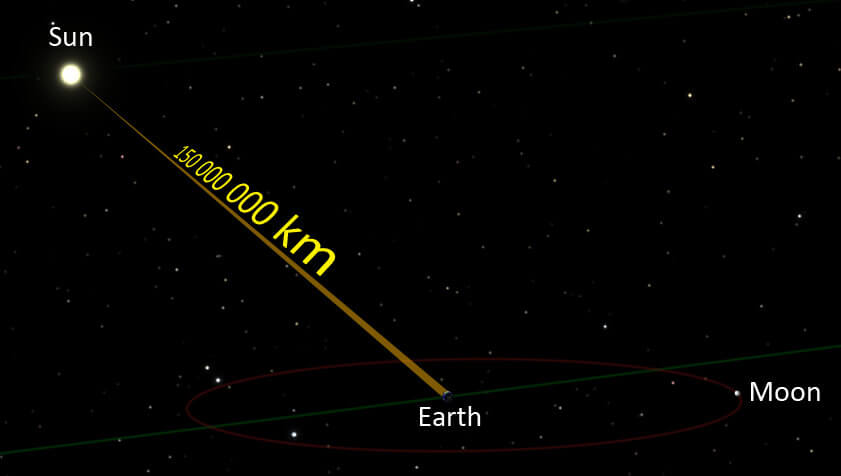
For example, the sun is at a distance of 150 million km from Earth. So, the light the sun emits at this moment (which is traveling at 300,000 km/sec) will need about 8 minutes to reach our eyes.
So when you look up at the sun, you are seeing the sun when it looked like 8 minutes ago.
The general formula for calculating how much time something takes given a certain distance and velocity (assuming constant velocity) is:
\( time = \dfrac{distance}{velocity} \)The distance between the sun and the Earth is 150 million km, so \( distance = 150,000,000\: km \). The speed of light is \( 300,000\: \text{km/s)} \)
\( time = \dfrac{150,000,000\: km}{300,000\: km/s} \)\( time = 500\: seconds \) (or 8,3 minutes)


Light travels through space in the form of a wave. If light waves are long (or stretched out), light will appear reddish. In contrast, if light waves are short (or squashed), light will appear blueish.
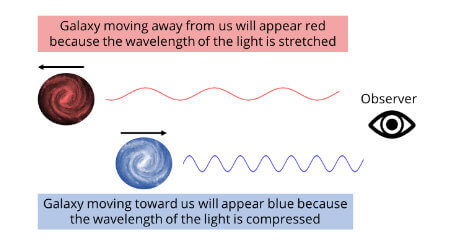
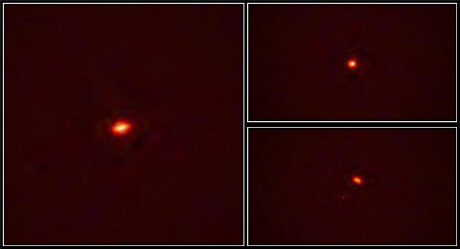
When astronomers look really, really far away in the sky, at the edge of what the most powerful telescopes can detect, what they see is that every galaxy is glowing red. What could this mean?
The light waves emitted from a galaxy or a star don’t have to stay the same length; they can be squashed (they will have a shorter wavelength and move towards the blue end of the spectrum) or stretched (they will have a larger wavelength and towards the red end of the spectrum).
So, scientists concluded that the reason the galaxies at the edge of the observable universe appear red to us is because space between us and these distant galaxies got stretched. Because space got stretched, the light that was given off by these galaxies got stretched as well on its way to us.
The logical conclusion from all this was that our entire universe is expanding.
To visualise what stretching of space means, think of the universe as the surface of a balloon with dots drawn on its surface representing the galaxies.
If you blow air into the balloon, it will expand, and the dots (the galaxies) will move away from each other.
So, when you blow air into the balloon, you are not adding new rubber to the balloon. Similarly, when space is stretched it doesn’t mean you are injecting new matter into the universe. Rather, it’s the fabric of space itself that is stretching (just like the surface of the balloon).

Now, as space continued to stretch, the wavelengths of light emitted from the very first galaxies got stretched so much that they went out of the light spectrum the human eye is able to detect. This light has been transformed into radio waves and microwaves. Scientists have been catching residues of this microwave light, which is known as Cosmic Microwave Background (CMB).
Cosmologists then posed an interesting question: if the universe is expanding, does that mean that if we could rewind the evolution of the universe, all matter in the universe would be closer together in the past? What if we continued to rewind? Will all matter be confined to a single point?
Two words: Big Bang!

The image of the Big Bang that has been overly popularised is that of a single point that explodes and shoots off matter everywhere in all directions. For years, this was the image I had about the Big Bang, but it couldn’t be more wrong.
The problem is that this idea falsely suggests that there was a specific place where the explosion occurred and that matter simply flung out from this focal point. This is wrong! The Big Bang, as scientists understand it, did stem from a tiny point of unbelievable density (a singularity) that expanded very rapidly. But it happened everywhere, and at the same time.
For me, it helps thinking of the big bang, not as a single explosion from a single point, but that of many, many little points exploding simultaneously, as the figure above illustrates.
So, galaxies are flying away from us not because the big bang hurled them into the void of the cosmos, but because space itself is stretching.
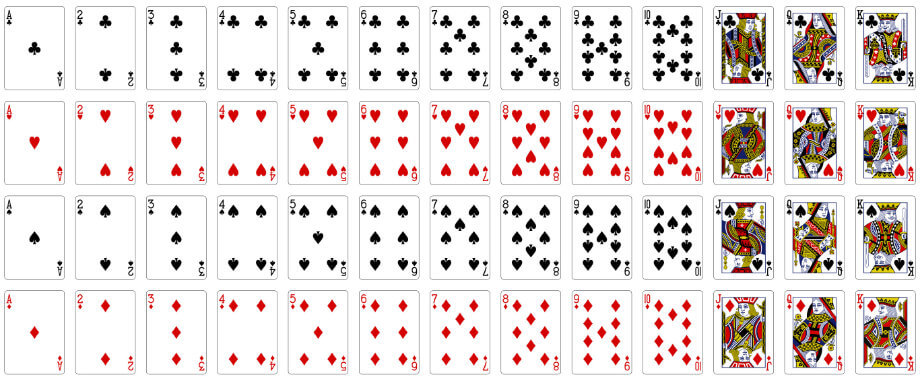
You may wonder that if the Big Bang created the entire universe, how much of it did it create?
One point I want to get out of the way from the get-go is that an infinite universe doesn’t imply infinite types of particles.
Imagine an infinite deck of playing cards. Even though you have an infinite amount of physical cards, the types of card are not infinite. In a standard 52-card deck there is an ace, numerical cards 2-10, a jack, a queen and a king in four different suits (clubs, hearts, spades and diamonds). So, if you kept drawing a card from your infinite deck of playing cards, the type of card would be bound to repeat.
The reason scientists believe that there are a finite amount of particle types in the universe has to do with the notion of the cosmological principle.
The cosmological principle states that the universe will appear uniform when viewed on the largest of scales. That is, no region in the cosmos is more special than the other.
You might argue “but what about our solar system, we’ve got Earth, the Sun, the other planets, surely that is special”. However, according to Albert Einstein, these are simply irregularities that can be largely ignored.

Let’s say you took a jar containing 100 million light-years of space stuff. Let’s call it Jar A. Now go to another corner of the universe and place 100 million light-years of space stuff into Jar B.
If you averaged the amount of galaxies, amount of matter, temperature, an so on in each jar there would be hardly any difference between the jars.
In fact, if you took 1 million jars they would all look identical. So the most obvious conclusion from this is that on a very large scale (100 million light-years across) space is pretty much uniform (i.e., it has the same kind of “stuff” everywhere).
Astrophysicists are happy to accept the cosmological principle as true (even though there are also reasons to believe it isn’t) because it makes Einstein’s equations of General Relativity far easier to solve – if the equations are applied to a uniform universe, they are essentially reduced to only one!
The implication of this is that no matter where you look within the observable universe (which has a radius of about 46 billion light years) we see that it contains pretty much the same types of matter. Look to the left and you’ll see types X, Y and Z. Look to the right, and you will still see X, Y and Z.
So it’s not a stretch to think that if the universe is indeed infinite, the same types of matter may exist everywhere in the entire universe (observable and unobservable).
The point I’m trying to make is that we can have a universe that extends infinitely with types of matter that are finite. And if types of matter are finite, the possible arrangements of those types of matter are also finite.
To make this a little bit more tangible, let’s say you are interested in finding all possible triplets consisting of letters X, Y and Z. So the arrangement XXX is one possible triplet, XYZ another triplet, YZZ another triplet and so on.
In this case, there would be 27 possible unique triplets; 27 ways letters X, Y and Z could be arranged in threes:
XXX, XXY, XXZ, XYY, XZZ, XYX, XZX, XYZ, XZY
YYY, YYX, YYZ, YXX, YZZ, YXY, YZY, YXZ, YZX
ZZZ, ZZX, ZZY, ZXX, ZYY, ZXZ, ZYZ, ZXY, ZYX
You can extend this reasoning by replacing letters with particles and triplets with universes. Of course, there are many many particles in the universe, so the number of possible configurations for all of those particles is enormous.
Impressively, scientists have actually calculated the possible number of distinct configurations of particles in our universe. As it turns out that number is about \( 10^{10122} \). This a mind-boggling number that is beyond human comprehension; just for reference, the number of atoms in the observable universe are a measly \( 10^{82} \) (or 10,000,000,000,000,000,000,000,000,000,000,000,000,000,000,000,000,000,000,000,000,000,000,000,000,000,000,000).
Still, however huge \( 10^{10122} \) may be, it is still a finite number.
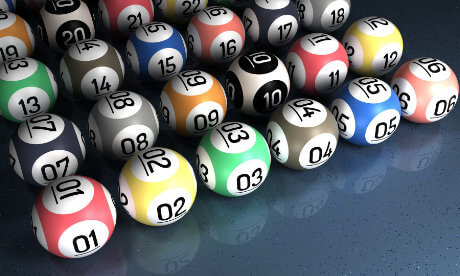
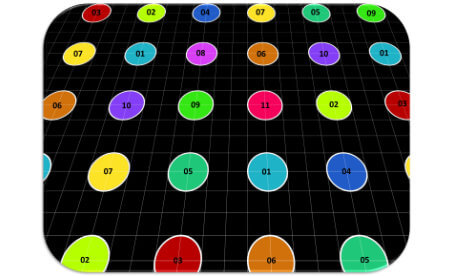
Imagine there exists an omnipotent being (let’s call her Dottie) with a bag of \( 10^{10122} \) universes in the shape of lotto balls. Dottie’s only job is to pick up a lotto universe and place it here and there in the infinite expanse of space.
Let’s also imagine that out of those \( 10^{10122} \) possible universe arrangements, our particular “lotto universe” is number 5.
Dottie draws the first lotto universe and it’s number 1021002. Second lotto universe and it’s 9993999892839. Third one is \( 10^{13} \), and so on and so forth. Our lotto universe (5) will eventually be picked, and there will be a point that no lotto universe is left in the bag.
Now, Dottie cannot be out of a job (there’s still plenty of space to cover – after all, it is infinite), so she grabs a new set of balls, puts them in the the bag and starts all over again. In fact, since the space with which she is working is infinite, she needs to keep drawing lotto universes an infinite amount of times, meaning that our universe (number 5) will also be picked an infinite number of times.
To state the obvious, in a universe that expands infinitely, but with a finite number of particle arrangements, there will be an infinite number of universes with worlds that look exactly like our Earth, with people that look exactly like us, and are doing the exact same things we are doing!
BOOM!!!!
It’s true that the greater amount of particles you have, the greater the number of possible configurations.
So, you could argue that perhaps universe 102 will have twice the number of particles than our own, universe 14 will have three times the particles of our own, and so on.
If this were the case, the universes might never repeat, because each could contain a different amount of particles, and hence either more or less possible arrangements of matter.
But here is the key: particles carry energy, so that means the more particles you place in a universe, the more energetic it becomes. And if a region of space has too much energy it will eventually collapse on itself and form a black hole.
The way I think about this is to imagine a paper bag that can hold a maximum weight of 4 kg. Place one milligram more and the paper bag tears.
Now, let’s assume an infinite source of potatoes, carrots and blueberries. If you put too many potatoes in the bag, say 21, the bag will tear. So there is a limit to how many potatoes you can place in the bag (up to 20 potatoes).
Let’s do the same with the carrots and blueberries and assume that the paper bag can hold up to 50 carrots or up to a 1000 of blueberries without tearing.
Great! We have established that 4 kg is equivalent to 20 potatoes or 50 carrots or 1000 blueberries.
Now, you cannot add 20 potatoes and 1 blueberry, because that extra blueberry will exceed the 4 kg max the paper bag can hold. So you can add 19 potatoes and 1 blueberry, that’s allowed, because it will be below 4 kg.
This means you are free to recombine potatoes, carrots and blueberries at your leisure, so long as their combined weight does not exceed 4 kg.
This constraint is what makes the possible arrangements of food stuff finite, even though there is an infinite amount of it.
You can think of the universe as a paper bag and the particles contained in the universe as the foodstuff. Even if there are an infinite amount of particles, within any given stretch of space (say the size of the observable universe, or about 93 billion light years across), there must be a finite amount of energy (similar to the 4 kg max of the paper bag). The particles within this space are free to recombine so long as they don’t go over this energetic upper limit.
The point to take home is that there is a limit to how much energy the universe can contain. Finite energy necessarily entails a finite number of particles, and a finite number of particles necessarily entails a finite number of configurations of those particles.
The maximum amount of configurations for the observable universe appears to be \( 10^{10122} \).
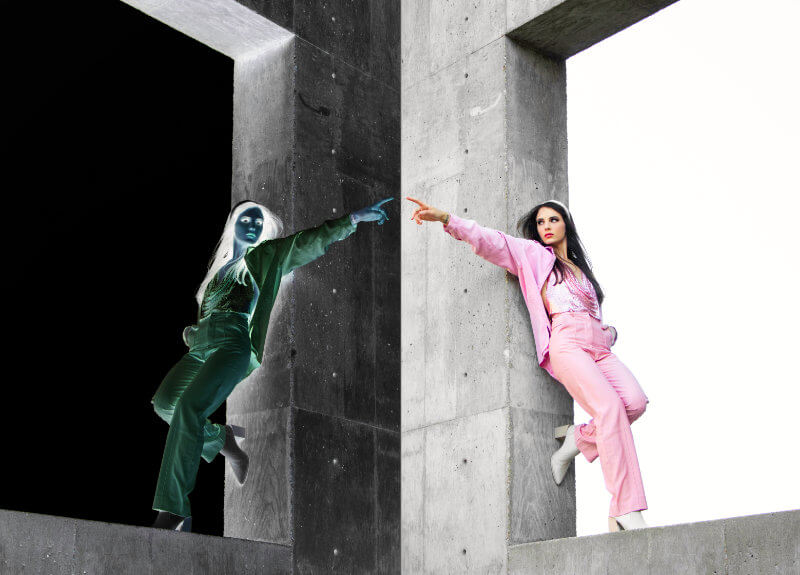
Before you decide to point your telescopes up in the sky, hoping to see another version of yourself, let me be the killjoy of the party to inform you that it will be a fool’s errand.
For fun, let’s see if we can grasp just how long it would take to create a universe that would look just as ours using our notion of time.
To warm you up for this task, think about a deck of 52 cards first. The 52 cards can be arranged in 80,658,175,170,943,878,571,660,636,856,403,766,975,289,505,440,883,277,824,000,000,000,000 ways. Let’s say we are only interested in one configuration: the original configuration that comes in the box (Ace, 2-10, Jack, Queen, King, first in clubs, then hearts, then spades and finally diamonds).
Assuming that all deck configurations are equally likely after each shuffle, if you picked a configuration every second, it would take about \( 8 \times 10^{67} \) seconds to get the one you wanted just by chance.
Well, the age of our universe is \( 5 \times 10^{17} \) seconds. And \( 5 \times 10^{17} \) seconds is way shorter than \( 8 \times 10^{67} \).
So it would take billions and billions and billions of “universe ages” just to draw the one configuration we wanted! And we are only working with a mere 52 cards.
The universe, however, has many more particles than 52. In fact, as I mentioned above, the amount of configurations for the particles in the observable universe is about \( 10^{10122} \), which is way, way, way more than the amount of possible configurations in the 52 cards.
So, the time you would have to wait to see another universe that looked exactly like ours is simply unimaginable, and the probability that it would be created in the vicinity to ours is practically 0.
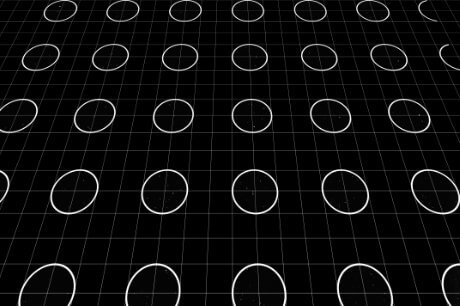
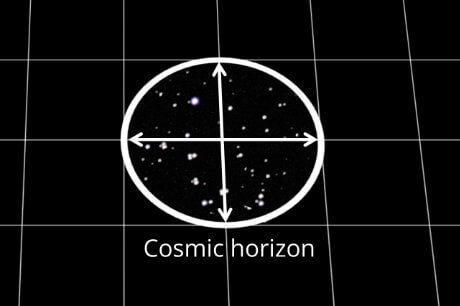
If your head hurts from all this, don’t panic. The key point is that with an infinite universe, you are guaranteed to have infinite repetitions of our observable universe. However, these realms are so, so, so, so, so, so, so, so distant from us that the expansion of the universe far outpaces the time light from these worlds will have time to reach us.
And if light isn’t able to reach us, no information at all can be exchanged between realms. Each realm is confined to its own cosmic horizon – the extent of space where interactions within the patch are possible (see figure above).
Famous astrophysicist Dr. Brian Greene suggested that our universe could be a bit like a patchwork quilt. Space would be filled with a multitude of universes (the patches) with their own independent cosmic horizon.
Even though our patch and other parallel patches inhabit the same physical universe, they are, for all intents and purposes, completely independent realms that will never ever have a chance to meet.
Boohoo…

The entire premise of the film is that there is another Earth just like ours, with people that look just like us, somewhere in the expanse of the universe.
As described above, there is nothing in the laws of physics that forbids such a scenario.
Indeed, in the bonus material of the DVD, Mike Cahill and Brit Marling discuss the science behind Another Earth with Dr. Richard Berendzen, a former professor of Astronomy. Dr. Berendzen mentions the idea of a multitude of universes, and the possibility of having exactly the same Earth in some of these universes (you can read the section The infinite universe to learn more about this).
The film ambiguity comes down to the last scene, when the two Rhodas meet. I’ll now elaborate on that below.
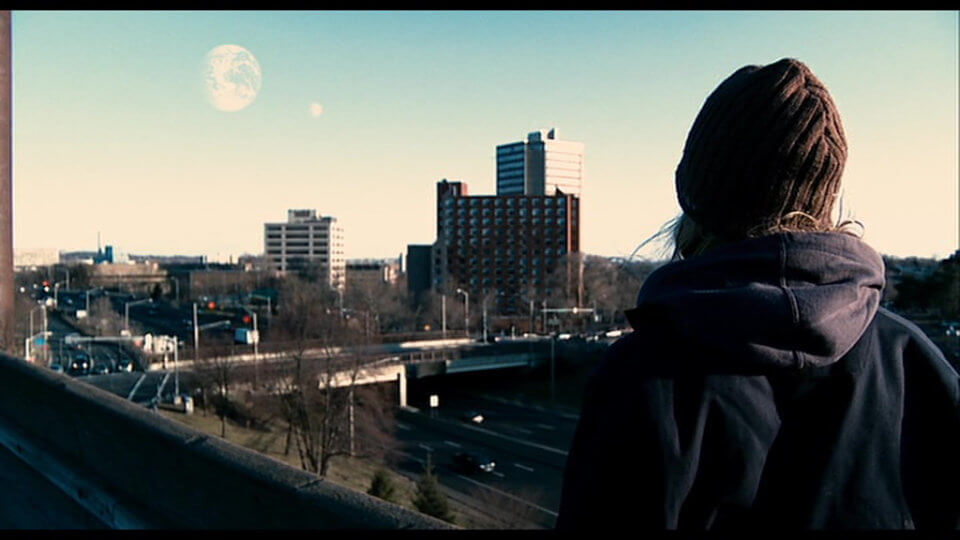
In the film, an astrophysicist called Dr. Richard Berendzen proposed the Broken Mirror Theory.
Here is the entire monologue:
“In the grand history of the cosmos, more than 13,000 million years old our Earth is replicated elsewhere. But maybe there is another way of seeing this world. If any small variation arises – they look this way, you look that way – suddenly, everything changes. And you begin to wonder: what else is different? Or one might say that you have an exact mirror image which suddenly is shattered and there’s a new reality. And therein lies the opportunity and the mystery. What else? What new? What now?”
Then Rhoda goes back to John’s house and tells him:
“They think that the moment we first saw the other Earth was the moment our synchronicity was broken. that was just over four years ago. Maybe they’re up there. Maybe not, but…maybe.”
So the theory tells you that every single event on Earth One and Earth Two was identical and happened at the same time (i.e., in synchrony). This synchronicity was disrupted as soon as someone on one the Earths sighted the other Earth. According to Rhoda, this synchronicity disruption occurred a few days before the fatal accident.
From the moment the synchronicity was broken, life on Earth Two simply went a completely different course than life on Earth One. Maybe Rhoda 2 missed the party where she got drunk and so the accident never happened. Maybe the car of John 2 wasn’t at the crossing. Endless possibilities.
Of course, there are arguments that could refute the Broken Mirror Theory.
For example, even if Earth Two was to miraculously wander in space with an accompanying Sun and Moon, every slight change in orbit, would be enough for synchronicity to be broken. People from Earth Two would surely have experienced many different things that people from Earth One would never have experienced.
I think we should simply ignore the plot hole, and assume that the inhabitants of Earth Two were oblivious to moving in space.

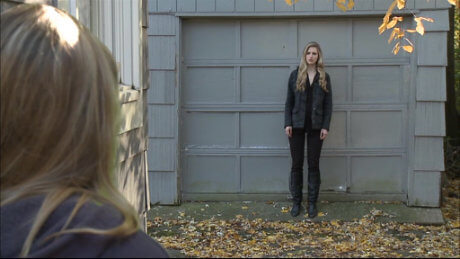
At the end of the film, Rhoda 1 is stunned to see her doppelgänger from Earth Two. Why did Rhoda 2 visit Rhoda 1?
As explained above, according to Dr. Berendzen, the proponent of the Broken Mirror Theory, the synchronicity of events between the two Earths was broken, once they sighted each other. According to Rhoda this happened over 4 years ago, a few days before the accident that took the life of John’s wife and son.
Now, assuming Rhoda is correct, it is safe to assume that Earth Two is nothing like Earth One. As Rhoda speculates, John’s wife and son could still be alive, and, by extension, the fatal car accident might never have happened.
This is corroborated by the appearance of Rhoda 2. There is a noticeable contrast in the clothing: since the accident, Rhoda 1 chose to wear loose clothing, such as tracking suits, loose jeans, and occasional long skirts. Rhoda 2, in contrast, is wearing a more classic style – in the bonus material, the meeting of the two Rhodas was shot twice (once in Summer and once in Winter), and in both scenes Rhoda 2 is clearly wearing more elegant clothes that Rhoda 1.
With this only clue, we can speculate that the producers wanted us to believe Rhoda 2 is well-off, and did not go through the struggles Rhoda 1 has.
But why is Rhoda 2 on Earth One? Was there also a contest on Earth Two that she won?
Hmmm, unlikely.
First of all, what would be the chances she would win? After all, it’s likely that Rhoda 2 is an astrophysicist, but without the accident, she is just another person.
The billionaire that came up with this competition was moved by Rhoda’s 1 story, a story which Rhoda 2 is oblivious of.
In addition, John 1 went to Earth Two four months before the two Rhodas met. Assuming that the Earths are technological identical, why did Earth One not receive visitors from Earth Two?
I think it’s more likely that there was no contest in Earth Two.
But, if that’s the case, why did Rhoda 2 visit Rhoda 1?
The interpretation I’m more inclined to believe is that Rhoda 2 met John 1, and John 1 told Rhoda 2 about the struggles of Rhoda 1 back on Earth One. Remember that John 1 left Earth One four months before Rhoda 2 visited Rhoda 1.
So maybe Rhoda 2 felt compelled to visit Earth One to offer some support to Rhoda 1. After all, Rhoda appears kind and compassionate with people around her (e.g., with the blind janitor).
Moreover, Rhoda is presented to us as a super talented student, that got into MIT, so she would presumably qualify for the journey.
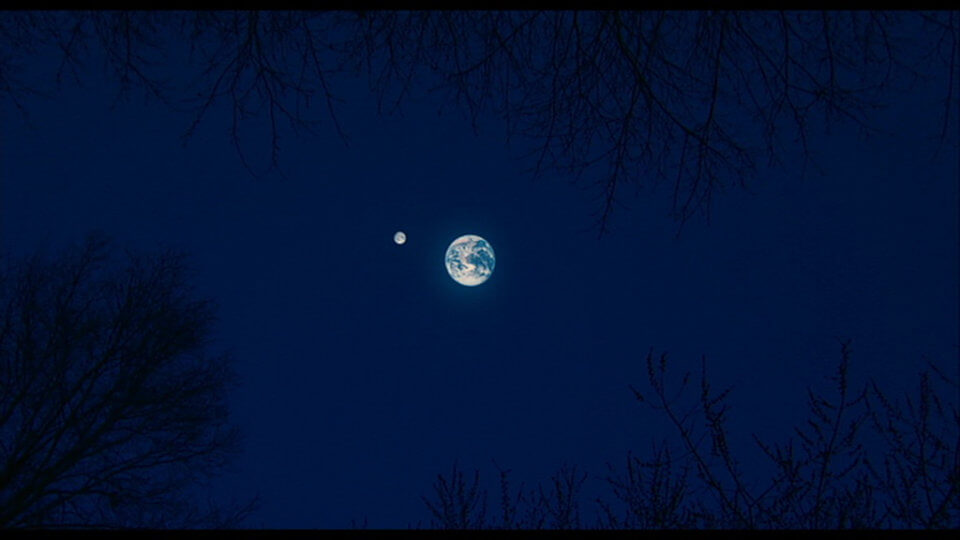
As the story progresses, we are never doubting that the events of the film are happening on Earth One, the Earth you and I are standing on.
But do we have any evidence that that is the case?
What made me question whether Earth One is really Earth One was something John says when Rhoda tells him she signed up for the competition to Earth Two:
“We call ourselves Earth One and them Earth Two. You think they called themselves Earth Two?”
John’s point is very good. Who is to say that the events we are witnessing in the film are happening on Earth One?
I’m assuming here that Earth One is the Earth that remained in the region of space that we are familiar with (in the Milky Way galaxy), and that Earth Two is the Earth that trespassed our solar system.
As I mentioned in the section Will I ever meet my doppelgänger(s)?, two identical Earths cannot possibly inhabit the same “universe” (or patch), let alone in the same galaxy. Clearly, one of the Earths must have been in transit across the universe until it ran into our solar system.
However fantastic this idea is, if Earth really roamed about the universe, the effects on the planet would be so extreme (e.g., there would be extreme alterations in temperature, gravity, Earth’s rotation, etc.) that it’s likely no living thing would be able to survive.
Maybe we could get away with the explanation that the entire solar system (i.e., the Sun, the other planets, all the asteroids and comets) just went along on the cruise. But then we face yet another conundrum: if there are two identical solar systems in the same region of space, shouldn’t we also be seeing two Suns?
So let’s set aside the plot hole, and imagine you are one of the inhabitants living on the Earth travelling across space. Even though you are the one roaming about the galaxy, you do not feel any different – there is no change in gravity, no alteration of sea levels, no unusual volcanic activity, etc.
From your perspective, the Earth you see on the sky is the “Earth Two”.
So, you see, there is absolutely no reason to believe that “Earth One” in the movie is our Earth.
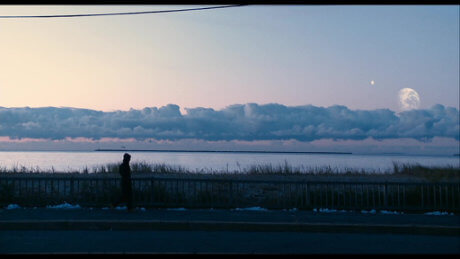
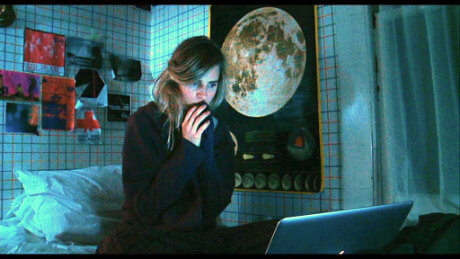
Unfortunately, not many clues abound that would allow us to make an educated guess. In fact, the production team was very careful to include a moon orbiting “Earth Two”, so that this ambiguity would be preserved.
I then thought maybe it is Earth One that does not have a Moon. In fact, I don’t remember the Moon being shown or even referenced at any point in the movie.
Although intriguing, it’s almost certain that there was a Moon on Earth One as well.
If you notice at about minute 09:16 into the film (when Rhoda is considering entering the competition for a visit to Earth Two), there is a poster of our Moon hung on the wall just behind Rhoda. Well, if the Earth where Rhoda was living really did not have a Moon, why would she have a poster of the moon that looks exactly like our natural satellite?
Of course, whether Earth One is really Earth One or Two has absolutely no impact on the story. Nevertheless, I find it curious that we are assuming from the the beginning that the events on the film are happening on Earth One (our Earth), when in fact, they may be happening on Earth Two.
Another Earth was a nice change of mood from all the over-the-top extra-planetary sci-fi films I had been watching.
The melancholy evinced by Rhoda and John was touching, and the inner struggle of both characters really came out in the movie – to me, Brit Marling and William Mapother are two very talented and underrated actors.
My only criticism is that, in my opinion, there should have been more care with the science behind the film. As mentioned in the Introduction, a simple consideration of the effects that the proximity of Earth Two had on Earth One would be fitting. The exchange of the ticket to Earth Two, as if it were a simple raffle ticket, was also somewhat absurd.
Having said that, we watch movies for the entertaining aspect, and I was entertained.
The main idea of the film is that the sighting of Earth Two broke the synchronicity of events between the two Earths – this is the Broken Mirror Theory. Of course, it’s a completely fictitious theory, but I thought it was snappy. They even had a real astrophysicist discussing it on TV during one the movie scenes, which I thought was a nice touch.
The disruption of synchronicity meant that the accident might not have occurred on Earth Two, so Rhoda gives her ticket to John to go on the journey to Earth Two in her place. A few months after John’s departure, Rhoda2 from Earth Two arrives on Earth One, perhaps to comfort Rhoda1 at John’s request. Based on what Rhoda2 is wearing, she probably didn’t endure the same vicissitudes as Rhoda1 and probably went on to become a successful astrophysicist.
Also, had the synchronicity not be broken, it should have been John2, and not Rhoda2, showing up on Earth One.
Finally, I briefly mentioned the possibility that Earth One may actually be Earth Two, the implications of which I’ll leave for the comments section.
This was my first article in which I had the opportunity to discuss the universe. And I genuinely loved it!!!
It’s a sobering thought that with an infinite universe there is the very real possibility that there are an infinite amount of Earths out there with someone that looks and behaves just like me.
How would we react if that theory could be proven true? Quoting directly from the movie:
“Can I go meet me? Is that me better than this me? Can I learn from the other me? Has the other me made the same mistakes I’ve made? Can I sit down and have a conversation with me?”
Man, how I wished I could know the answer to those questions! 🙂
See you in the next article!
Great article! A question is the rotation of Earth 1 and Earth 2, and what they see of each other because of their different positions in relation to the Sun. I guess Rhoda 2 could not see Earth 1 (lit by the sun) through her car window and therefore did not cause the accident.
Hi Andreas,
Yes, that’s a very good observation!
Indeed, I agree that Rhoda 2 couldn’t possibly have been looking at Earth One at the time of the accident. For that to happen, the American continent of each Earth would have to be facing each other, and that would imply that the American continent of Earth Two had to be facing the sun, in which case Earth One wouldn’t be visible at all.
I mentioned somewhere in the article that synchronicity probably broke as soon as Earth One inhabitants caught sight of Earth Two, and that must have happened way before the accident.